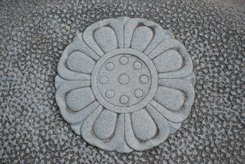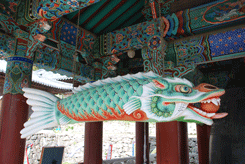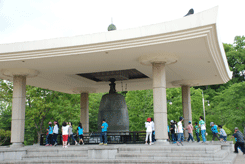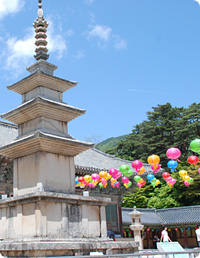Temples
 |
 |
 |
Temple motifs (Korean Temple Motifs by Heo Gyun)
Lotus
The lotus is one of the most common motifs at a Buddhist temple. The flowers are found almost everywhere, from the depictions of the Buddha and bodhisattvas on lotus thrones, to the altar and ceiling, to door frames and brackets, pagodas, reliquaries, and even roof tiles. People unschooled in Buddhism are likely to consider the lotus as mere adornment, but the flower is imbued with profound symbolism for Buddhism believers and the Buddhist spiritual worlds. The lotus flower seed never go rotten and germinates some other day. Although the lotus flower takes root in liquid mud, it flowers beautifully and smells nice and fragrant, totally untainted by muddy water. Similarly, although this world is dirty and foul just like the muddy pond water where one person envies another's good fortune or intrigues against their friends, if you can lead an honest life following Buddha's teachings, you are certain to be reborn in the Land of Pure Bliss in the afterlife. Thus the lotus flower stands for Buddhism's doctrine of reincarnation. The lotus was associated with the notions of creating the universe and coming into being. This "world lotus belief" is linked to the concept of spontaneous "lotus transformation rebirth", i. e. a birth not by gestation. Pure Land Buddhists believe that by entrusting themselves to the Buddha's wisdom they can be reborn on a lotus when they are reincarnated in the Pure Land of West.
Dragon
Korean dragons resemble the traditional Chinese version, with features such as a bovine head, deer-like antlers, serpentine belly and fishy tail. Bewhiskered and clawed, they often appear with magic pearl in their mouth. Physical similarities aside, the nature and symbolic meaning attributed to dragons differ between the two countries. The dragon at Korean Buddhist temples combine the traditional Chinese appearance with the Buddhist meaning and character of the Naga (dragon) imported, along with Buddhism, from India. The Indian snake spirit was adopted as a protector of the Dharma Truths teaching of the Buddha. The serpentine form of the deity was different from the dragon spirit found at Korean temples today. In its spread eastward, Buddhism first went to China, where the snake image was dropped in favor of the dragon, and Korean Buddhism, first received from China, also adopted the dragon motif. The snake/dragon spirit, also known as the snake/dragon king is among the eight classes of supernatural beings. The most eye-catching figures at a temple are the heads carved into the top of the central pillars at the front of the Buddha hall or the dragons on the sides of the staircases leading to the hall. Sometimes, the heads are jutting out form the building front and the tails are embedded into the building. The symbolism is of a "wisdom dragon ship heading for Paradise ”. Buddhism speaks of a means - namely the wisdom to perceive reality - to carry believers across the "sea of Samsara ” to the other shore, where the Pure Land is said to exist.
The monster mask
Usually the carved or painted images glare out from under the eaves or at the top of the pillars in front of the halls or adorn the altar inside. On closer inspection, one will notice bulging semicircular eyes and a wide nose with flaring nostrils. The face comes with hair, whiskers and ears, and large horns jut out left and right from above the eyes. The symbolism of monster is for repelling evil spirits and protecting the Buddhism.
The Apsaras
Apsaras are most commonly found on temple bells, but sometimes they appear on the stone lantern, stone reliquaries, and altars as well as within the colorful Dancheong paintings. These celestial creatures praise the Buddha while flying about in the rarified air of the Buddhist heavens, sprinkling flowers as they play musical instruments and dance. They resemble the female immortals of Taoist lore, the trails of their heavenly robes fluttering about. In ancient Indian myth, apsaras did not drink wine nor eat meat, subsisting only on fragrance. Their bodies also emanated fragrance, earning them the appellation "god of fragrance and music", but the music they performed was termed "secular". They were referred to as heavenly music gods or singing and music gods. The apsara on bell Silla King Seondok, now housed in the Gyeongju National Museum, presents an object with both hands while kneeling on a lotus seat, a posture befitting a bell cast specifically to wish a deceased king happiness in the afterlife.
Swastika
Swastika depicts a cross rotating around a fixed point. The perpendicular lines at the ends of the cross are meant to convey motion. The fixed point at the centre represents the absolute form which emanates the principles of the universe. If one considers the cross as the representative symbol for Christians, the same can be said about the swastika for Buddhists. This is the sign used most frequently to identify buildings as being part of a Buddhist temple. The emblem also appears on rafters, roof tiles and the turtle-shaped pedestals for steles as well as in Buddhist painting. The original, right-facing version is called Svastika in Sanskrit, a reference to lucky or auspicious objects, especially certain marks on persons and things that denoted good luck. From the ancient times, it has functioned as an artistic and decorative motif for peoples as diverse as the Indians, Persians, Greeks and even North American natives. The swastika has been a religious symbol for traditions such as the Brahmans and the Jains, and the Hindus attribute the origin of the emblem to the auspicious light beam emanating from the curl of hail on Vishnu's chest. The swastika is also among the numerous auspicious signs believed to be on the chest and feet of Sakyamuni and is used as the seal on the Buddha's heart.
The fish
One will discover painted or sculptured fish all around the Dharma halls - on the pillars, brackets, ceiling and walls. Sometimes the fish appears alone, while at other times it is presented along with various other aquatic animals such as crabs, snapping turtles, clams and frog. The fish symbolizes the primordial freedom and religious practice. Fishes are not restricted to the lotus pond at temples; they also suspended in thin air. They adorn the chimes that dangle from the ends of eaves of temple buildings. In addition, the fish's eyes remain open when asleep or awake; they do not close their eyes even after death. The clear, tinkling melodies of the wind chimes also continue day and night without end, promoting some to say the clapper shape helps remind meditating monks to always be alert and, like the fish, never doze off. The large hollow-out logs that are used as percussion instruments stand out among the fishy figures found in the temple belfry. It is among the four Dharma instruments along with the large leather drum, cloud-shaped gong, and Brahma bell.
The supreme ultimate
It explains the duality of Yin and Yang within the myriad forms of the universe and refers to the supreme ultimate as the source of all things. The 64 hexagrams were developed within this framework and used to interpret philosophical, ethical and political issues. The supreme ultimate diagram is used as temple adornment because the principle of reciprocity and interfusion coincides with the Buddhist teaching. The triple-comma symbol represents the three powers of the heaven, the earth and the humankind in such colors as red, blue, and yellow. It stands for three laws: that Yin and Yang establish the Way of Heaven; that softness and hardness establish the Way of Earth; and that the benevolent and the righteousness establish the Way of Humankind. The triple-comma supreme ultimate symbol shows the separateness of its components, the same principle represented by the dual-comma version, and it also portrays the concepts of interdependence and interfusion.
The circle
The circle is a simple and concise image, but it represents a profound truth related to the Buddhata in Mahayana Buddhism. Buddhists borrow circle to symbolize the Daharma truth. The Buddhist term "insightful illumination" means intelligent contemplation used to gain enlightenment on the eternally immutable truth and the true nature of all things. Meditation via this insightful illumination method is important in finding the truth implied in the background of the circle. The truth implied in the figure of the circle can neither be explained nor elaborated upon. The only way to grasp reality is to use the circle as a contemplative technique for gaining personal insight into the Dharma truth.
The Altar
The altars that elevate statues of the Buddha in the Dharma Halls are called either Buldan or Sumidan in Korean. The altar is either square or rectangular and symbolize mythical mountain that stands at the center of the world. The altar is covered in beautiful and mythical decorative patterns. Fascinating animals from the spirit world, auspicious signs from the real world and symbolic Buddhist images are interwoven, making the altar a treasure trove of Buddhist art. Supernatural motifs found on the altars are imaginary birds, land creatures, fish, a creature with human head on a bird's body, bat-winged dragon, merman, humanoid with a turtle shell, phoenix, or a monster mask. Not all Buddhist altars are covered with imaginary creatures. The altar depicts a scene inspired by ordinary life. The diverse subjects include the hare and snapping turtle, lotus, peony, apsara, white elephant, fish and shrimp.
Dancheong
It is the traditional painting style for building decoration. These elaborate and colorful paintings cling to eaves and ceilings, drape pillars and hug corners. Korea has some of the best in the world. As you move through a temple, you'll begin to notice recurring symbols. Lotus blossoms are everywhere. It is an art of painting introduced into Korea along with Buddhism in the 4th century. Korean traditional buildings like palaces, temples, shrines and gates are painted with amazingly bright colors in geometric patterns. These designs are called Dancheong, literally meaning Red and Blue. The principal colors are red, blue, white, black and yellow. Such manner of decoration was strictly prohibited from the residences the during Silla period, but allowed only for palaces, official buildings and temples. The main aim of Dancheong is to protect the wood. The wood is carefully treated before applying the pigments in order to protect it from humidity and decay. Then the design for painting is outlined using chalk powder over pinholes made in the paper of the design. Only then the wood is ready to receive the bright colors of the mineral paints used. Finally a coating of oil is applied and the paintings are gone over with a hot iron. In this way the wood is protected from the elements as well as from mold and bugs.
The latticework
The wooden design on the doors and windows of traditional Korean homes or palace buildings are typically modest and symmetrical as witnessed in character door and belted grid door patters. Temple doors are extremely ornate by comparison. The diagonal grid, upright diagonal grid and upright diagonal floral design are the most common motifs on the entrance for the central halls. The often seen diagonal grid is an intricate mesh of vertical and horizontal strips called Jeongjamun that have been set at a 45-degree angle, while the upright version is this same diagonal grid with a vertical strip added at each intersection of the diagonal ribs. In both instances, the mesh is believed to ward off evil spirits.
The canopy
A palace within the Buddhist hall most often seen at Korean temples are made of finely interlaced brackets that have been ornately decorated, and feature long, slender pillars that hang down without touching the floor. One can better understand the Sukhavati, Pure Land of Ultimate Bliss that appears in the Amitabha Sutra Sukhavati is surrounded by seven tiers of railings and rows of trees decorated with the bells and four treasures (gold, silver, lapis lazuli and crystal). There is always heavenly music, and the ground is yellow gold. Three times each day and night, a heavenly rain of Madarava (white lotus) falls. Flocks of swans, parrots, peacocks and other birds sing forth harmonious and elegant sounds. Their clear and joyful sounds proclaim the teachings of the Buddha, and when living being of this land hear these sounds, they are all mindful of the Three Treasures of the Buddha, Dharma and Sanga. Desiring that the Dharma sound be widely proclaimed, Amitabha Buddha created this multitude birds. The canopy in Buddhist halls are divided into (1) cloud palace type, (2) treasure palace type, and (3) bejeweled canopy type. The canopy presents a Pure Land image in order to conceal the unclean secular world with its endless cycle of birth and death.
The nimbus
The symbol of emanations of wisdom and authority, a nimbus represents the aura said to emanate from the Buddha's body and is normally divided into two types, light from the head and light from the body. The nimbus shape is also categorized as precious gem type when flames are shown flaring upward and boat type when the top is pointed like a ship's prow. In every case, the nimbus is a means for showing the light of wisdom and truth. The Buddha is said to be endowed with 32 fundamental or major marks and 80 minor characteristics of a great being. The ray of the light radiating from the Buddha is the psychic energy of Enlightenment and a mark of wisdom. Hence, the term mark of wisdom light refers to the Buddha's aura. This ray penetrates darkness of delusion and falsehood to reveal the Truth. It is a boundless light that shines in all directions constantly, rendering the Buddha's body a storehouse of infinite emanation. This boundless light can be symbolically portrayed as coming either from the head or from the body.
The pagoda
The pagodas were originally hemispherical burial mounds in India. They were adopted in Buddhism for the enshrining the Buddha's relics. Most of the pagodas seen today in Korea are made of stone and include three main sectors-- the Base, Body and Finial. The pagoda base is typically decorated with the images of the twelve spirit generals, eight Dharma protectors or four heavenly kings. The body is made up of a body stone topped by a roof stone. Images of the benevolent kings, four heavenly kings or bodhisattvas are carved on the body stone faces. The final is set above the pagoda body. Its Korean name is Sangnyun means the 'sing of wheels'. It refers to the 'nine circular wheels' or 'sacred wheels' placed directly under the 'water flame' design at the top of the pagoda. The finial components are stacked up on a vertical shaft from the finial base in a given order: base, invented bowl, upturned lotus, sacred wheels, sacred canopy, water flame, dragon wheel, and sacred pearl. The pagoda has been always the central object of Buddhist worship, as it was the reliquary of the Buddha's remains.
The stupa
The pagoda is used to enshrine the relics of Sakyamuni Buddha. The stone reliquary for monks is stupa. The stupa shrines for ordinary monks are typically placed in a quite isolated area and gazing at them can cause one to ponder the meaning of life and death. In Buddhism, the life and death is explained by the theory of co-dependent arising, which postulates that all things are dependent upon various casual conditions. In other words, all the various phenomena in the world are made up of separate discrete elements. Co-dependent arising is based on the principles of 'no permanence' and 'no Self'. The former is temporal concept; all things are subject to birth, death and constant change- nothing stands still. The latter is a spatial concept that says nothing has an intrinsic nature of its own.
The Lion images
The 'king of beasts' is an excellent metaphor for the Buddha's solemnity. The lion leads an exceptional existence among the beasts that run on four legs. It fears nothing and can easily subjugate all. In this same fashion, the Buddha brings all of the 96 heresies into submission at once and thus is called the man-lion. The phrase 'the lion's instant Samadhi' suggests the Buddha's awe-inspiring power like a lion. Many other lion-related symbols exist in Buddhism. The Lion mind/heart is a comparison with the Buddha-mind. The lion is the most powerful and fearless of all the animals, and the Buddha's mind excels above all else. The term lion milk, a metaphor for the boddhi (enlightened) mind, appears in Frascicle 78 of the Flower Garland Stura.
The four Buddhist instruments
Korean Buddhist temples utilize four percussion instruments; the Brahma bell, Dharma drum, wooden fish and cloud shaped gong. They are used to summon people, keep time during chanting and also serve as ritual instruments that, when stuck, produce the sound that can save the sentient beings in the ten directions. In the morning, it tolls 28 times, 33 times in the evening. The number of strikes on the temple bell has significantly different meanings. Twenty-eight strokes imply the incessant lineage of Buddhist tradition from Sakyamuni Buddha to the Sixth Patriarch, Huineng (638-713). Thirty-three tolls signify the Buddhist realms of 33 celestial worlds. 108 times mean that all sentient beings can be relieved from all the earthly delusions, agonies and evil passions numbering 108 by the Buddhist viewpoint.
The fundamental significance of the temple bell's toll is to awaken the sentient beings to the solemn truth of the Dharma and to rescue those who are suffering in the hell. The Dharma drum is struck during various rituals or lectures. It symbolizes spreading the Dharma and saving all sentient beings. Wooden fish or Mokeo symbolizes all the creatures living in water. Cloud shaped gong called Unpan that represents all the sentient beings in the air is made of metal in the shape of a cumulus cloud. On the plate, the image of Buddha or phrase of sutra is usually inscribed. The sounds of four Buddhist instruments are symbolic of great vows to save, or enlighten, the creatures in the universe including those on land, in the sea, in the air and in hell.






